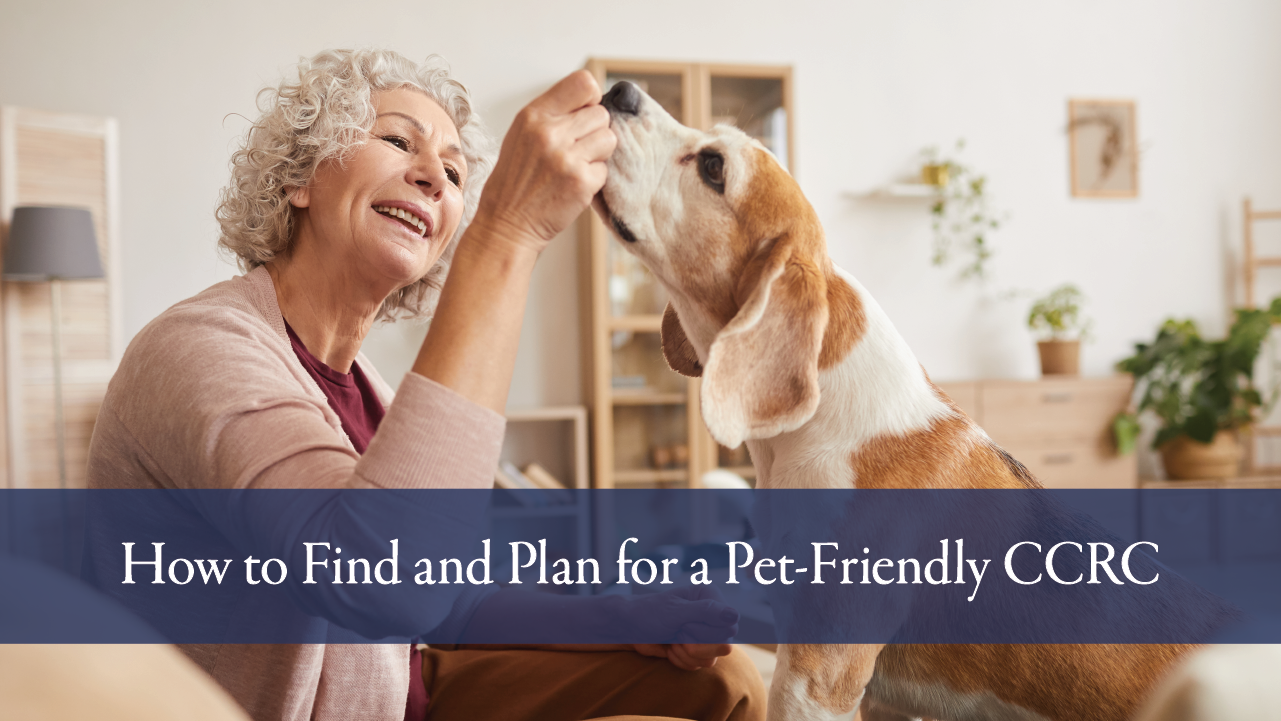
09 Aug How to Find and Plan for a Pet-Friendly CCRC
As you or your parents think about what the later years of retirement might look like, have you stopped to think about what that season of life will look like for your pets? If you’re worried that moving into a retirement community or assisted living facility will mean rehoming your four-legged friend, you’ll be relieved to know that isn’t always the case. Many CCRCs allow pets now, so with the right planning, there’s no reason to retire to your happy place without bringing Duke or Mittens along. Studies have shown senior citizens who own pets enjoy many benefits besides the obvious companionship, including improved mental health, lower blood pressure and cholesterol levels, and better cognitive function. Here’s what you need to know so you can bring your beloved pet with you into this next chapter of life.
Do Your Research
Make sure you ask the right questions when you start looking for a pet-friendly CCRC. Along with our list of considerations to find the right fit for your needs, you’ll want to learn everything there is to know about the facility’s pet guidelines. Do they have restrictions based on weight, breed/pet type, and temperament? Is there a pet deposit, and how much is it? What about pet-friendly communal spaces, dog-walking services, and vaccination requirements? Some facilities may also have noise restrictions or require you to have a local designated pet caretaker in case you need assistance caring for your pet. Ask up front so you have all of the information you need in order to make the best choice for yourself and your furry friend.
Plan for Their Exercise… And Yours!
As you look at rooms or apartments in retirement communities, don’t forget to think about how it will affect you when your pet needs to answer nature’s call. A ground-floor unit with outdoor access will make it much easier to head out for a W-A-L-K whenever the urge or mood strikes. Speaking of exercise, making sure your pup gets the activity they need does just as much good for you as it does for them! You might not always feel like getting out, but a little encouragement from human’s best friend can be just the nudge you need to get some fresh air. In fact, a study found that dog owners walked an average of 22 minutes more per day than those who didn’t own a dog. Thanks for the cardio, Bandit!
Ease the Transition
Once you’ve thought about the logistics, it’s time to think about how you can minimize stress for your pet. Changes in routine and environment can be scary and trigger anxiety for your fur baby, but a little planning ahead goes a long way. As you’re packing and cleaning before your move, resist the urge to wash their bedding and toys. Having a familiar smell in a new space can help your pets acclimate faster. Consider taking them with you to visit their new home before moving day, and plan to slow down and spend a little extra time with them during those first few weeks. Hiding treats or toys around your new home for them to discover and enjoy will also help them realize this new home is pretty great! If they tend to be anxious, or if you notice new behaviors after your move, talk to your vet about ways to help mitigate anxiety, like supplements or pheromone diffusers. And don’t forget to update their microchip information as soon as you’ve finalized your move.
Must Love Dogs
One of your best resources for a pet-friendly move is to find other pet parents! If there are dog-walking groups or other residents who own pets, they can provide valuable insight on finding a new vet, local dog parks, etc. You’ll get the inside scoop on pet care and activities while starting to make shared-interest connections for yourself. You can also learn from other residents if there are doggy daycares, boarding facilities, or local pet sitters nearby. It’s a good idea to have a plan for backup care if you need to be away for a period of time or become unable to fully take care of your pet on your own.
We can’t imagine having to choose between our furry friends and living in a retirement community, and we don’t think you should have to either. After all, these four-legged friends bring much joy to our lives, and helping you plan for a joy-filled retirement is what we’re all about. Check out our other resources on settling into a CCRC, and let us know how we can help you retire to your happy place.



